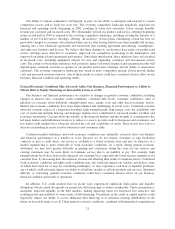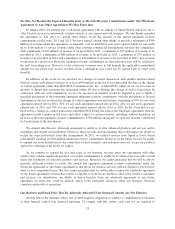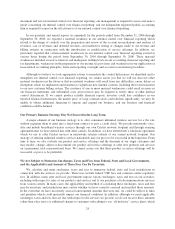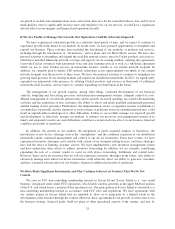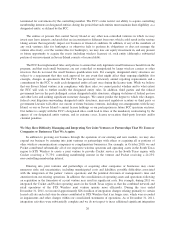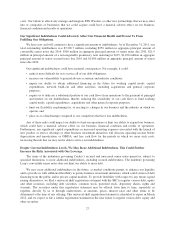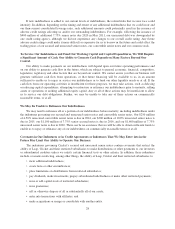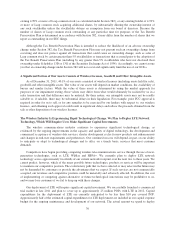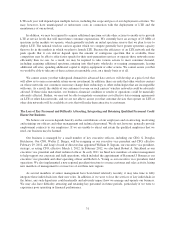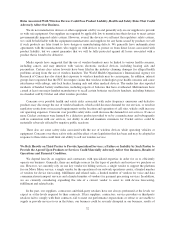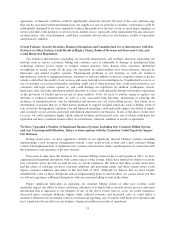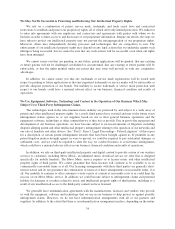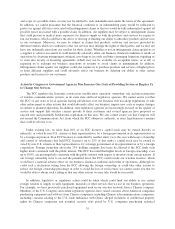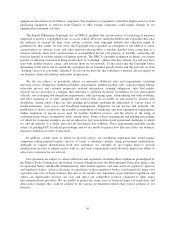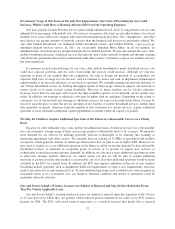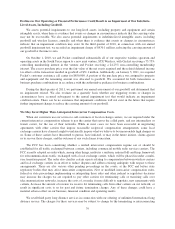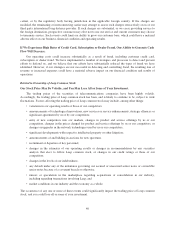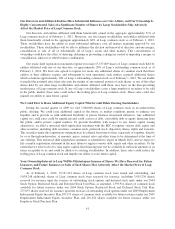Cricket Wireless 2011 Annual Report Download - page 41
Download and view the complete annual report
Please find page 41 of the 2011 Cricket Wireless annual report below. You can navigate through the pages in the report by either clicking on the pages listed below, or by using the keyword search tool below to find specific information within the annual report.LTE each year will depend upon multiple factors, including the scope and pace of our deployment activities. We
may, however, have unanticipated or unforeseen costs in connection with the deployment of LTE and the
maintenance of our network.
In addition, we may be required to acquire additional spectrum or take other actions to enable us to provide
LTE at service levels that will meet future customer expectations. We currently have an average of 23 MHz of
spectrum in the markets we operate, which generally include an initial spectrum reserve that we plan to use to
deploy LTE. The national wireless carriers against which we compete generally have greater spectrum capacity
than we do in the markets in which we plan to launch LTE. Because the efficiency of an LTE network and the
peak speeds that it can deliver depend upon the amount of contiguous spectrum that is available, these
competitors may be able to offer faster speeds for their next-generation services or operate those networks more
efficiently than we can. As a result, we may be required to take various actions to meet consumer demand,
including acquiring additional spectrum, entering into third-party wholesale or roaming arrangements, leasing
additional cell sites, spending additional capital to deploy equipment or other actions. We cannot assure you that
we would be able to take any of these actions at reasonable costs, on a timely basis or at all.
We cannot assure you that widespread demand for advanced data services will develop at a price level that
will allow us to earn a reasonable return on our investment. In addition, there are risks that other wireless carriers
on whose networks our customers roam may change their technology to other technologies that are incompatible
with ours. As a result, the ability of our customers to roam on such carriers’ wireless networks could be adversely
affected. If these risks materialize, our business, financial condition or results of operations could be materially
adversely affected. Further, we may not be able to negotiate or maintain cost-effective data roaming agreements
on LTE or other data networks, and we are not able to assure you that customer devices that operate on LTE or
other data networks will be available at costs that will make them attractive to customers.
The Loss of Key Personnel and Difficulty Attracting, Integrating and Retaining Qualified Personnel Could
Harm Our Business.
We believe our success depends heavily on the contributions of our employees and on attracting, motivating
and retaining our officers and other management and technical personnel. We do not, however, generally provide
employment contracts to our employees. If we are unable to attract and retain the qualified employees that we
need, our business may be harmed.
Our business is managed by a small number of key executive officers, including our CEO, S. Douglas
Hutcheson. Our CFO, Walter Z. Berger, will be resigning as our executive vice president and CFO, effective
February 29, 2012, and Leap’s board of directors has appointed William D. Ingram, our executive vice president,
strategy, as acting CFO, effective March 1, 2012. In February 2012, we also hired Robert A. Strickland as our
executive vice president and chief technical officer. In early 2011 we hired new members of senior management
to help support our corporate and field operations, which included the appointment of Raymond J. Roman as our
executive vice president and chief operating officer and Robert A. Young as our executive vice president, field
operations. We also implemented a new regional president structure to oversee customer and sales activity, hiring
new members of management to oversee two of our three new regions.
As several members of senior management have been hired relatively recently, it may take time to fully
integrate these individuals into their new roles. In addition, if we were to lose the services of key individuals in
the future, any such departures could materially and adversely impact how we manage and operate our business.
We may also have difficulty attracting and retaining key personnel in future periods, particularly if we were to
experience poor operating or financial performance.
31


